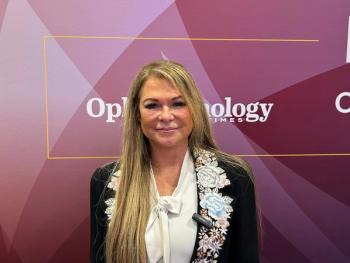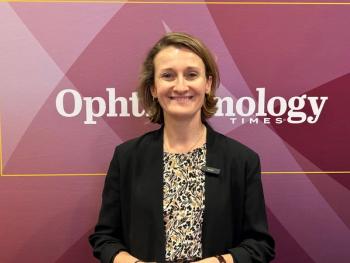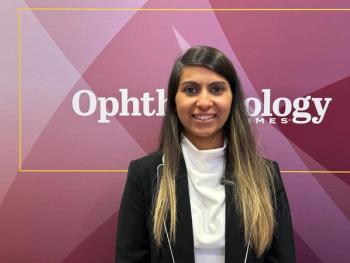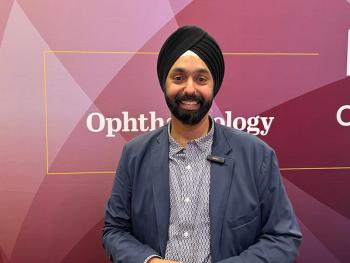
Faricimab: YOSEMITE, RHINE treat-and-extend data illustrate favorable personalized treatment dynamics for the treatment of DME
Roger A. Goldberg, MD, MBA, discusses his 2022 AAO poster: "T&E-Based Personalized Treatment Interval Dynamics in the YOSEMITE/RHINE Trials of Faricimab in DME."
Video transcript
Note: This transcript has been lightly edited for clarity.
Sheryl Stevenson: We're joined today with Dr. Roger Goldberg, who will be presenting this year from the podium at Academy. Welcome to you, Dr. Goldberg. Could you tell us a little bit more about your talk this year?
Roger A. Goldberg, MD, MBA: Sure. I'm happy to be presenting some of the details from the YOSEMITE and RHINE clinical trials, and particularly that the arm of the trial where patients were treated with what's called a personalized treatment interval or variable interval, testing kind of the the efficacy and durability of faricimab, now known as Vabysmo, with a generic faricimab, for the treatment of diabetic macular edema.
Fariciamb, of course, is a bispecific antibody designed to inhibit both VEGF-A and Angiopoietin-2. And the YOSEMITE and RHINE trials were twin phase 3 studies, both very large over 900 patient trials, compaing faricimab given every eight weeks, faricimab, with this personalized treatment interval or PTI arm, which is basically kind of a treat-and-extend-based dosing regimen, where patients can be tested anywhere from every 4 all the way out every 16 weeks, based on both changes in the central subfield thickness on OCTs, so the amount of fluid on the OCT, as well as the visual acuity. And the comparator arm was aflibercept, dosed on label at a Q 8-week interval. All of these of course after a couple of loading doses.
Of course, the top line results from both YOSEMITE and RHINE is that faricimab showed excellent results the Q 8 or the PTI arm in terms of visual acuity gains and non inferior to on-label aflibercept. And the central subfield thickness, the OCT changes, again excellent results in both YOSEMITE and RHINE.
And the PTI arm in particular performed excellently both visual acuity wise and anatomic wise looking at the central subfield thickness.
And a lot of us, when we do treat-and-extend algorithms, although the visual acuity of courses is important, that is less consistent in our clinic, unlike in a clinical trial, where they use what's called best-corrected visual acuity, but we rely a lot of course on our exam and on what we see in the OCT. And here, I think it's really important that when we're looking at the efficacy and durability of faricimab, particularly in this PTI arm. How does it compare versus aflibercept? And couple different ways to look at that on OCT.
One is with what they call the absence of DME, which is the central subfield thickness less than 325 microns, or just throughout the macula, absence of intraretinal fluid. And across both of those measures, you know, kind of two different ways to try to quantify what we see on OCT, faricimab, both given every 8 weeks or the PTI arm, again, where patients can be extended up to 16 weeks, excellent results, and statistically better drying agents than aflibercept given every 8 weeks across both of those measures, absence of DME or absence of intraretinal fluid.
And that's really consistent importantly, basically across all time points after the loading period. And what that shows is that even with PTI being able to extend patients out all the way out potentially to 4 months, it's still kind of anatomically a better drying agent. So I think that was an exciting result for the PTI arm.
Now, the question of course, is, well, how many of the patients were able to be dosed at this extended interval, and if you look at the patients in this PTI arm, across both YOSEMITE and RHINE, we saw over three quarters of patients 78%, were able to go Q 12, or Q 16 weeks, so every three or four months. And of that, over 60% of both trials were able to go out to that 16-week interval, so well over half to 16 weeks, and over three quarters to 12 or 16 week interval.
So basically comparable in terms of visual acuity, frankly, better drying agent, and a huge proportion of patients able to go 3 months or longer between treatment. In fact, there was an option for patients to be dropped down into even monthly treatment. And at the end of year 2, there were about 10% of patients on a Q 4 week interval, 7% in YOSEMITE, 10% in RHINE, and that's kind of how the study ended in 2 years. We'll continue to follow these patients in the Rhone-X study.
The safety of faricimab, a very well tolerated, very comparable adverse event profile in the Q 8-week arm, in the PTI arm, and in the aflibercept Q 8-week arm, a safety profile, comparable of aflibercept and frankly, what we expect to see with intravitreal injections.
One of the other ways we tried to look at the kind of this treat-and-extend algorithm, the PTI, is with these heat maps, where it kind of follows every single patient and what their interval of dosing is. And what we see here is that kind of, there's already a huge swath of patients who are able to kind of quickly advance on a monthly interval, most of us do treat-and-extend in 2 weeks steps, but in the PTI arm, they actually were extended 4 weeks at a time. And so there's a big swath of patients are able to increase kind of straight away out to 16 weeks, expanding at 4 week intervals.
And then over time, we see kind of a, an increasing proportion of patients who are able to get out to 16 weeks over time. And then there is a cohort of patients on the order of about 20%, that do seem to have a more variable phenotype, they're able to go up a little bit, they're able to move back a little bit, and it's less consistent. And then of course, there's that very small kind of mid-single digit percentage that does require a Q 4-week treatment even with faricimab.
So I did share a couple of examples in the in the talk here, but obviously in this scenario, I won't be able to show them, but to summarize, the PTI arm really kind of simulates what we do in real clinical practice with treat-and-extend. The majority of patients, again, over three quarters, were able to get to Q 12 or Q 16 week intervals, they're able to kind of get there by week 52 and then maintain it out a year or 2, will actually continue to see further extension during the what's called Rhone-X extension studies, which continues to follow the YOSEMITE and RHINE patients.
And the safety was excellent, no cases of retinal vasculitis and so really shows the promise and potential of enhanced drying and extended durability. So all in all, really important clinical trial program. And I think many of us now have experience using it in the real world.
Sheryl Stevenson: Excellent. Thank you.
Newsletter
Don’t miss out—get Ophthalmology Times updates on the latest clinical advancements and expert interviews, straight to your inbox.



















































.png)


